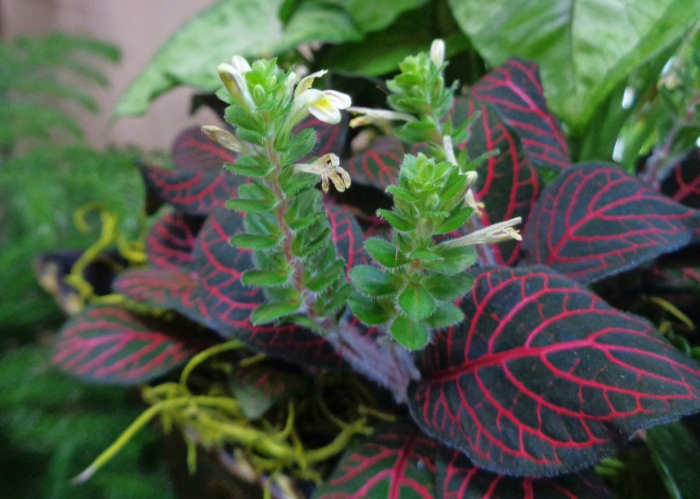Nerve Plant
(Fittonia albivenis)
Nerve Plant (Fittonia albivenis)
/
/

Andrey Zharkikh
CC BY 2.0
Image By:
Andrey Zharkikh
Recorded By:
Copyright:
CC BY 2.0
Copyright Notice:
Photo by: Andrey Zharkikh | License Type: CC BY 2.0 | License URL: https://creativecommons.org/licenses/by/2.0/ | Uploader: AndreyZharkikh | Publisher: Flickr |
























Estimated Native Range
Summary
Fittonia albivenis, commonly known as Nerve Plant, is an evergreen perennial herb native to the tropical rainforests of South America. It typically grows to a modest height of 15 cm (6 in), featuring lush green, ovate leaves that are 7 to 10 cm long. The leaves are notable for their striking vein patterns, which can range from white to deep pink, and the stems are covered with a short fuzz. While it occasionally produces small, inconspicuous white to off-white flowers, the plant is primarily grown for its ornamental foliage. The contrasting veins against the dark green leaves make it a visually appealing addition to indoor plant collections.
The Nerve Plant thrives in a humid environment with mild, indirect sunlight, making it suitable for terrariums and as a houseplant in temperate regions. It prefers fertile, peat-based substrates and consistent moisture, as it can wilt dramatically ("faint") when dry, though it recovers quickly with watering. Its spreading habit is ideal for ground cover in indoor garden settings. Fittonia albivenis can be challenging to grow from seed, so purchasing established plants from nurseries is recommended. The Argyroneura Group and the Verschaffeltii Group are popular cultivars that have earned the Royal Horticultural Society’s Award of Garden Merit. In cultivation, it does best in part shade with medium water requirements and well-draining soil. Despite its beauty, it can be sensitive to overwatering, which may lead to root rot, and it requires high humidity to prevent leaf crisping.CC BY-SA 4.0
The Nerve Plant thrives in a humid environment with mild, indirect sunlight, making it suitable for terrariums and as a houseplant in temperate regions. It prefers fertile, peat-based substrates and consistent moisture, as it can wilt dramatically ("faint") when dry, though it recovers quickly with watering. Its spreading habit is ideal for ground cover in indoor garden settings. Fittonia albivenis can be challenging to grow from seed, so purchasing established plants from nurseries is recommended. The Argyroneura Group and the Verschaffeltii Group are popular cultivars that have earned the Royal Horticultural Society’s Award of Garden Merit. In cultivation, it does best in part shade with medium water requirements and well-draining soil. Despite its beauty, it can be sensitive to overwatering, which may lead to root rot, and it requires high humidity to prevent leaf crisping.CC BY-SA 4.0
Plant Description
- Plant Type: Herb
- Height: 0.3-0.5 feet
- Width: 0.5-1 feet
- Growth Rate: Slow
- Flower Color: N/A
- Flowering Season: Summer
- Leaf Retention: Evergreen
Growth Requirements
- Sun: Part Shade
- Water: Medium
- Drainage: Medium
Common Uses
Groundcover, Potted Plant
Natural Habitat
native to the tropical rainforests of South America
Other Names
Common Names: Silver Fittonia, Mosaic-Plant, Silver-Nerve, Silver-Threads, Nerveplant, Snakeskinplant, Silver Netleaf, Silver Netplant, Silbernetzblatt
Scientific Names: , Fittonia albivenis, Fittonia argyroneura, Fittonia verschaffeltii, Fittonia verschaffeltii var. argyroneura, Fittonia pearcei, Fittonia verschaffeltii var. verschaffeltii, Adelaster albivenis, Eranthemum rubrovenium, Eranthemum verschaffeltii
GBIF Accepted Name: Fittonia albivenis (Lindl. ex Veitch) Brummitt